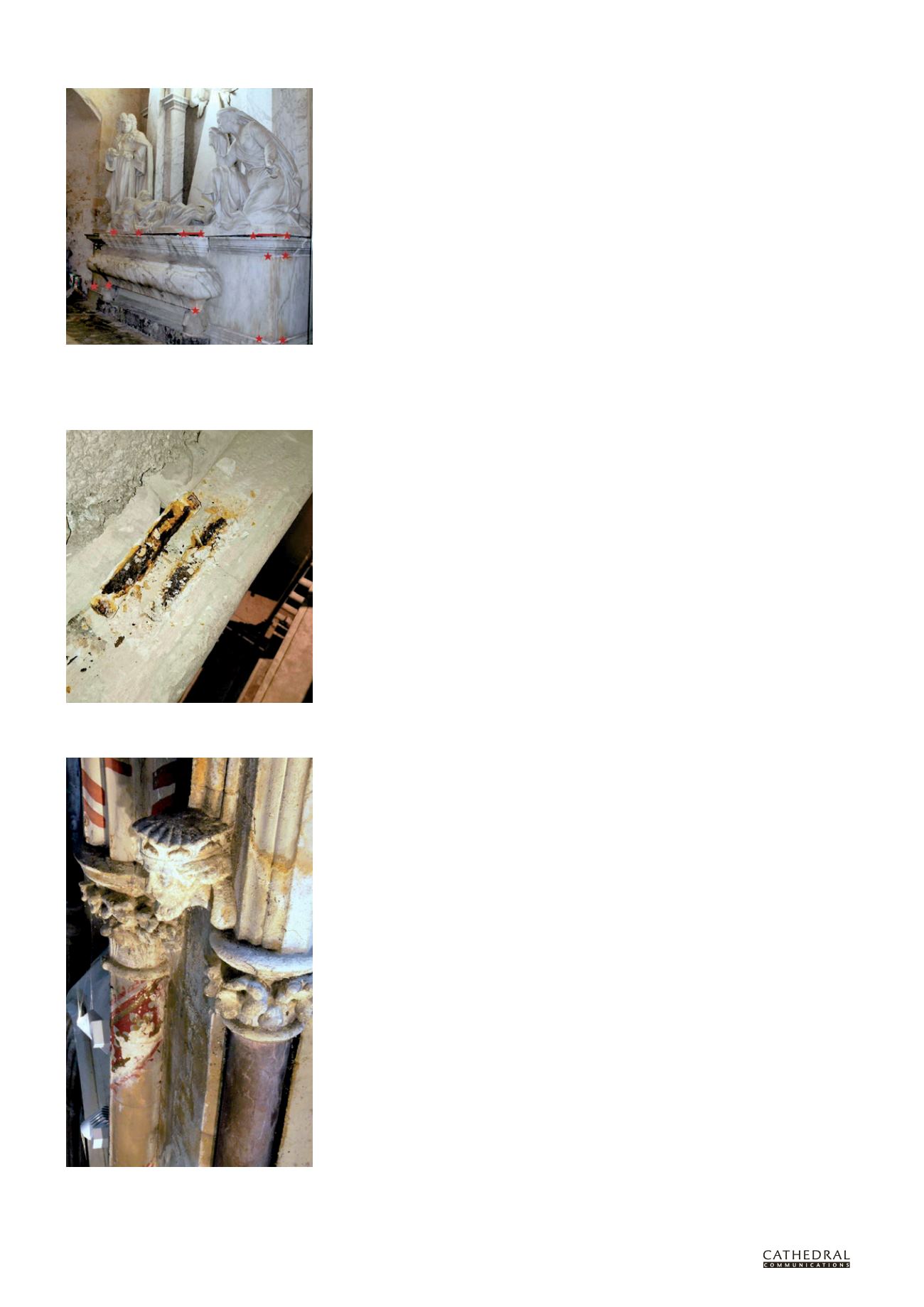

14
BCD SPECIAL REPORT ON
HISTORIC CHURCHES
24
TH ANNUAL EDITION
to areas of pigment. This relentless decay
mechanism is particularly damaging
to the fine limestones widely used for
architectural detail and monuments
as they are vulnerable to damage by
sulphates, chloride and nitrate salts.
Deterioration of historic paint
layers, biological growth and surface-
staining of church monuments can be
associated with the microclimate and
repetitive cyclical changes in temperature
and humidity. Condensation can form
on surfaces which are colder than the
general environment, contributing
to ongoing salt activity, staining and
deterioration of paint layers. The
problem of spring condensation in
churches – when warm, humid air
enters the building and condenses on
interior fabric – is well-documented.
MANAGING THE ENVIRONMENT
Because critical decay mechanisms such
as the corrosion of iron fixings and salt
activity are associated with different
forms of moisture, it is essential to reduce
the levels of moisture within the fabric.
A detailed inspection of roof coverings,
rainwater goods and drainage is necessary
to identify any defects. This may not
be as straightforward as it sounds.
Historic churches often have complicated
roof structures and drainage systems
which have been subject to numerous
adjustments. The ground level around
churches can gradually become elevated
as drainage channels are dug out and
other debris builds up. Moisture readings
should always be taken on the internal
fabric surrounding the monument as
well as on the monument itself to assist
in understanding how the building
distributes moisture.
The external walling must also be
inspected. Decay and fracturing to the
stonework with hairline cracking and
failure to the pointing will dramatically
increase the levels of moisture
immediately behind and around the
monument. The presence and extent
of cement mortars should be recorded
because they reduce the surface area
through which moisture can evaporate
significantly. Cement mortars also cause
ongoing damage to the surrounding
historic stonework.
The condition of the external
fabric needs to be addressed before a
monument conservation programme can
begin and this can present a significant
and sometimes unexpected cost to the
local community. Improvements to the
drainage system can be complicated by
raised ground levels, the presence of
underground water systems and more
The monument to the Hon Robert Dormer
(d1726), Church of the Holy Cross, Quainton,
Buckinghamshire, showing the location of the iron
fixings and the significant movement through the
joints caused by the corroding iron fixings
The canopy to the monument to Sir Edward and
Lady Francis Rodney during dismantling showing
corroded iron fixings
of historic decoration, including pigment
and sometimes gilding. All these materials
are subject to decay mechanisms
associated with moisture, either as a
liquid or a vapour, which can compromise
the structural integrity of the monument
and cause surfaces to deteriorate, leading
to a loss of detail and decoration.
Typically, the cause of structural
movement is the deterioration of the
system of iron fixings used to construct
the monument. Iron is susceptible to
corrosion in the presence of moisture
and air. This causes the fixings to expand,
exerting pressure on the sections of
stone and often resulting in dramatic
movement through the joints, cracking
and buckling. Rust ‘jacking’ has the
power to lift substantial free-standing
elements, destabilising them. An example
of this can be seen on the monument to
Robert Dormer (illustrated above left),
which is attributed to the great Flemish-
born sculptor John Michael Rysbrack.
Here, two large sculptures have been
lifted out of position through pressure
exerted by the corroded iron fixings.
Once the pointing mortar falls out, this
type of deterioration accelerates due to
the greater exposure of the iron to both
moisture and air.
The critical factor which draws the
attention of the PCC and architect to a
church monument is usually evidence of
movement through the joints, sections of
the monument shifting out of alignment
and associated iron-staining on the
surface. At this stage a monument may
pose a significant threat to public safety
and demands investigation.
Surface deterioration often indicates
high levels of moisture in the building
envelope and the internal environment.
Historic fabric will always retain moisture
and soluble salts and the management
of salt activity is one of the biggest
challenges in the treatment and care of
church monuments. Cyclical changes
in temperature and relative humidity
in the microclimate can trigger an
acceleration in the movement of soluble
salts through porous material towards the
surface, where they move out of solution
and crystallise either on the surface
(efflorescence) or just behind the surface
(cryptoflorescence).
Some salts are hygroscopic and
draw moisture in from the surrounding
microclimate, causing them to dissolve
and recrystallise in the pores of the
material in increasing concentrations.
The force of crystal growth, like rust
expansion, can be substantial, breaking
down the integrity of the pore structure
and leading to blistering, spalling and loss
Salt crystallisation damage at a high level caused by
warm, moist air condensing on cold fabric


















